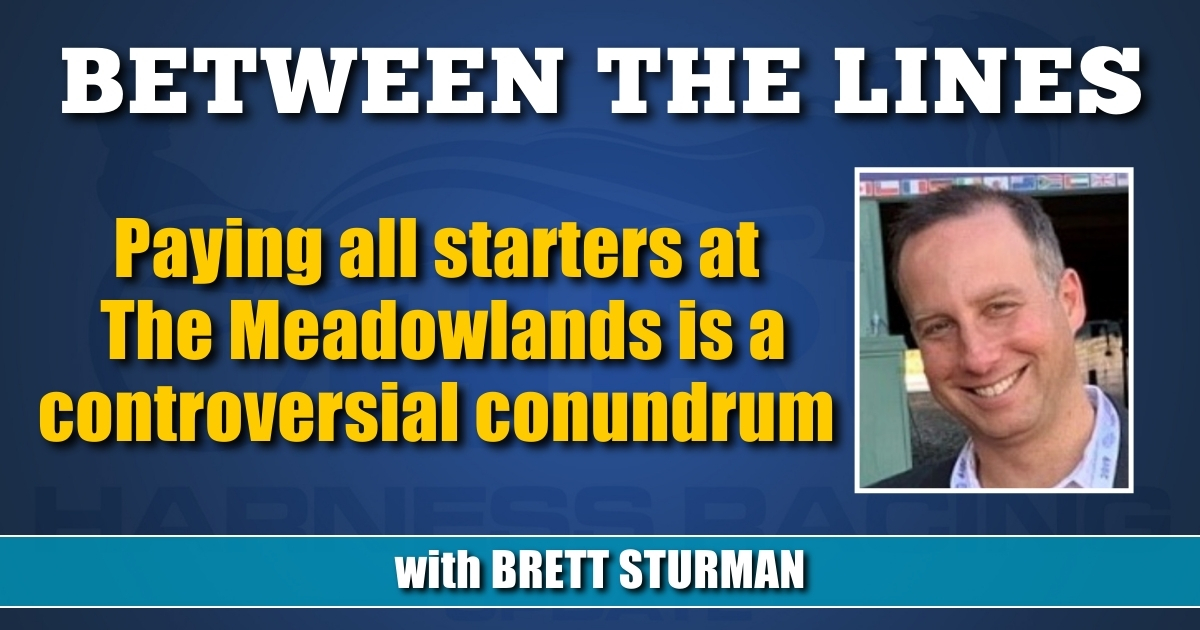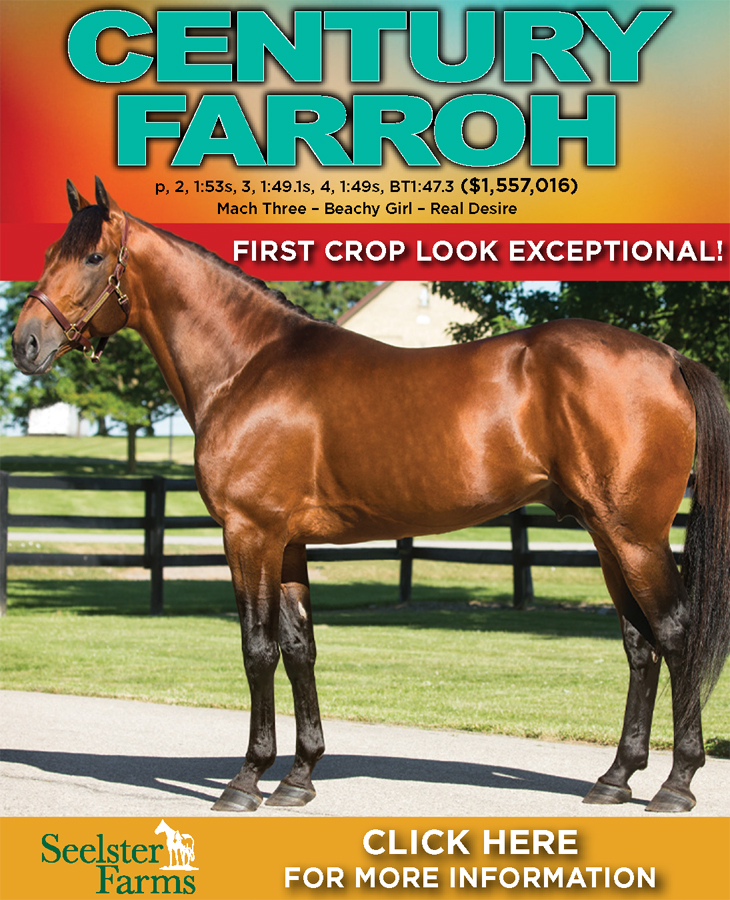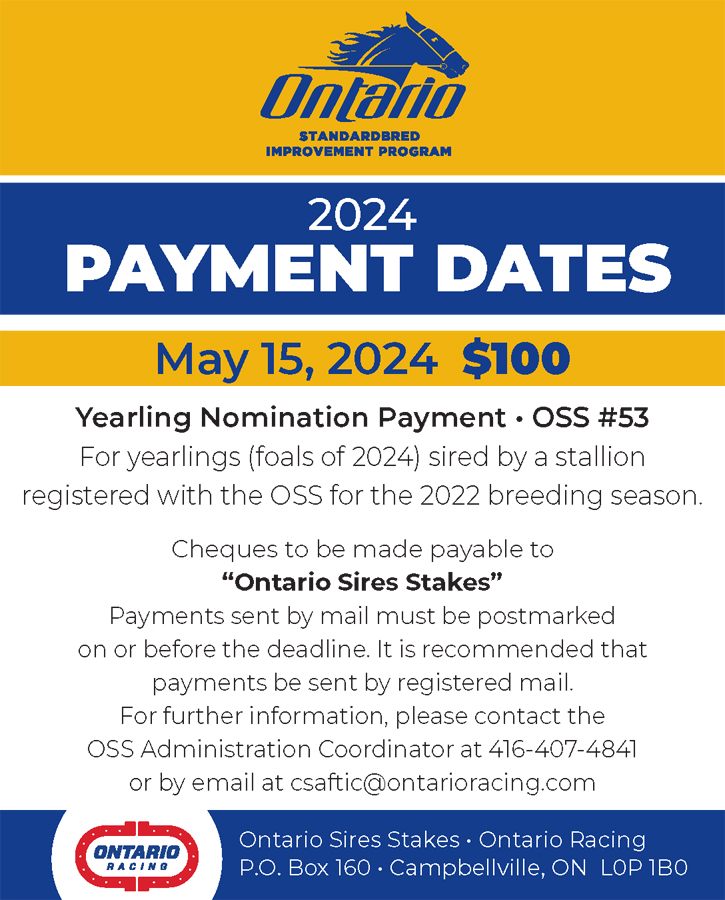

Paying all starters at The Meadowlands is acontroversial conundrum
Trying to ensure full fields to drive handle is a noble goal, but perhaps The Big M and the SBOANJ got the percentages wrong in the interest of increasing full effort.
by Brett Sturman
Beginning with races last weekend, The Meadowlands has worked with the Standardbred Breeders and Owners Association of NJ (SBOANJ), and has started a pilot exercise that will pay all starters in overnight races. Deviating from the tradition of paying only the first five starters in a race, all starters will now come away with no worse than three per cent of the total purse. The trial is initially expected to last until June 1.
The distribution changes based on the number of starters, but let’s go with the example of 10-horse fields, since attracting full fields is one of the aims of the program. With 10 horses, the purse distribution will change from the standard 50-25-12-8-5, to 46-21-9-6 and then three per cent all the way down to the 10th. In this model, fifth place would earn the same as 10th.
Debate seen online since the initiative was first announced has been fierce. At one end is the thought that the winners now supplement the losers. At the other end is the feeling that a broader sharing of the purse is for the greater good.
I have no issue with all starters receiving at least something for showing up and contributing to a full field, which helps handle. And like many reading this right now, we know firsthand the increasingly high expenses associated with racehorses; even more-so on race days. I’m empathetic to those in favor of wanting a small piece of the purse regardless of the outcome.
Then there is the question of whether guaranteeing money to everyone will lessen the quality of the racing product. Meaning, if you’re going to get the same amount for 10th as you are for fifth, where is the incentive to try harder than necessary? I don’t buy this one, either.
By its very nature, of horses racing week in and week out as it is, there’s already a mentality of not overusing a horse and waiting another week for an easier spot. Offering three per cent to those towards the back isn’t going to incentivize them any more than usual to not provide an aggressive effort if they weren’t going to do so anyway.
Where the issue does come in is where the 15 per cent (three per cent for horses six through 10) is coming from, which is from the share of the top finishers.
The incentive to finish first and get paid accordingly for doing so should take priority over what to pay all other finishers. This way, all owners, trainers, drivers, and bettors are equally aligned in an objective.
Diluting the winning percentage from 50 per cent to 46 per cent doesn’t particularly take away an incentive to win, but at that rate the winners aren’t being compensated as much as they should. Let me give you an example.
A different model for sure, but in thoroughbred racing the purse distribution is more top heavy. Generally speaking, 60 per cent goes to the winner and 20 per cent goes to second and in some cases, it could swing even further. The percentages continue downward from there with eventually all starters leaving with something, same as what The Meadowlands has started doing. But the difference is that in this model, there is a massive premium put on winning. Anything less than a second — and even that is basically breaking even — isn’t going to pay the bills for the month. On the other hand, if you win here or there then you’re set for a while. The idea being that there is a clear emphasis on the need to win. Not to hit the board, not to collect a check, not to get them next time, but to actually win.
Winning and collecting 46 per cent of the purse at The Meadowlands may still seem “fair,” but is it? After factoring in all the shipping expenses already cited as reason enough why everyone needs at least three per cent on top of all the other race day expenses and commissions, you’re not left with as much as you’d think.
The irony is that The Meadowlands is taking 15 per cent from the top finishers to pay for places six through 10 in order to attract 10-horse fields as tracks like Harrah’s Philadelphia opens, but now, you’ll get only 46 per cent for winning a race with 10 horses at The Meadowlands as opposed to simply going to Philly anyway where you can get 50 per cent for racing with eight horses. If The Meadowlands wants to try this route, I’d at minimum have kept the winner at 50 per cent and reduced gradually from other placings.
I don’t think the experimental purse distribution model is a net positive for the horsepeople for the reasons above, but there is something to be said for doing what’s necessary to ensure full fields for wagering and handle, things of utmost importance at The Meadowlands. The same thing can’t be said for other places.
Take Yonkers, which in the example of the Borgata series has clearly prioritized distributing purses to as many participants as possible more than compiling full race fields.
In last Monday’s first Borgata legs, there were 24 horses spread out across four divisions of six horses each when there could have easily been and should have been three full fields of eight horses each. In a time when other tracks are doing what’s necessary to make full fields, here’s an example of dismantling full fields for smaller ones.
The point being, there’s already a lot going on of distributing purses to as many participants as possible. That’s all fine and good and again, maybe even necessary to keep things going for many operations; no problem there. But at some point, there needs to be a focus on returning the highest amount possible of the purse to the winners. The entire idea of even being in a race in the first place should be to win.
The Meadowlands is trying to thread a needle between ensuring full fields needed for wagering as competing tracks reopen while at the same time making it worthwhile to not only race there, but to win there. For now, I think they are more right than wrong in the approach.














